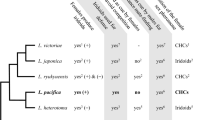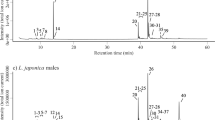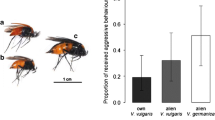Abstract
Gregarious parasitoids usually clump their cocoons together and the adults emerge in a synchronized fashion. This makes it easy for them to find mating partners and most copulations indeed take place at the natal patch. Yet, males should leave such sites when females are no longer receptive. As yet, this decision-making process and the possible involvement of pheromones were poorly understood. Here we report on a remarkable use of attractive and repellent pheromones of the well-studied gregarious parasitoid species Cotesia glomerata (L.) (Hymenoptera: Braconidae). Virgin C. glomerata females were found to release an attractive as well as a repellent compound, which in combination arrest males on the natal patch, but after mating the females stop the production of the attractant and the males are repelled. The repellent compound was identified as heptanal, which was also released by males, probably reducing male-male competition on the natal patch. We also confirmed that the sex ratio of the emerging wasps can vary considerably among patches, depending on the relative quality of hosts and the number of females that parasitize a host. The newly revealed use of attractive and repellent pheromone compounds by C. glomerata possibly helps maximize mating success under these variable conditions.






Similar content being viewed by others
References
Andersson J, Borg-Karlson A, Wiklund C (2000) Sexual cooperation and conflict in butterflies: a male-transferred anti-aphrodisiac reduces harassment of recently mated females. Proc R Soc Lond B Biol Sci 267(1450):1271–1275. https://doi.org/10.1098/rspb.2000.1138
Ayasse M, Paxton R, Tengö J (2001) Mating behavior and chemical communication in the order Hymenoptera. Annu Rev Entomol 46(1):31–78. https://doi.org/10.1146/annurev.ento.46.1.31
Bates DM. 2010. lme4: mixed-effects modeling with R. http://lme4r-forger-projectorg/book/. Accessed 29 Oct 2018
Boulton RA, Collins LA, Shuker DM (2015) Beyond sex allocation: the role of mating systems in sexual selection in parasitoid wasps. Biol Rev 90(2):599–627. https://doi.org/10.1111/brv.12126
D'Alessandro M, Turlings TCJ (2005) In situ modification of herbivore-induced plant odors: a novel approach to study the attractiveness of volatile organic compounds to parasitic wasps. Chem Senses 30(9):739–753. https://doi.org/10.1093/chemse/bji066
Davison AC, Ricard I (2011) Comparison of models for olfactometer data. J Agric Biol Environ Stat 16(2):157–169. https://doi.org/10.1007/s13253-010-0042-6
De Freitas MDT, Mendonca AD, Do Nascimento RR, Sant'ana AEG (2004) Behavioural evidence for a female sex pheromone in Cotesia flavipes (Hymenoptera: Braconidae). Physiol Entomol 29(2):183–187. https://doi.org/10.1111/j.0307-6962.2004.0385.x
Desurmont GA, Xu H, Turlings TC (2016) Powdery mildew suppresses herbivore-induced plant volatiles and interferes with parasitoid attraction in Brassica rapa. Plant Cell Environ 39(9):1920–1927. https://doi.org/10.1111/pce.12752
Elias J, Dorn S, Mazzi D (2010) Inbreeding in a natural population of the gregarious parasitoid wasp Cotesia glomerata. Mol Ecol 19(11):2336–2345. https://doi.org/10.1111/j.1365-294X.2010.04645.x
Gilbert LE (1976) Postmating female odor in Heliconius butterflies: a male-contributed antiaphrodisiac? Science 193(4251):419–420. https://doi.org/10.1126/science.935877
Godfray HCJ (1994) Parasitoids: behavioral and evolutionary ecology. Princeton University Press
Gu H, Dorn S (2003) Mating system and sex allocation in the gregarious parasitoid Cotesia glomerata. Anim Behav 66(2):259–264. https://doi.org/10.1006/anbe.2003.2185
Gu H, Wang Q, Dorn S (2003) Superparasitism in Cotesia glomerata: response of hosts and consequences for parasitoids. Ecol Entomol 28(4):422–431. https://doi.org/10.1046/j.1365-2311.2003.00535.x
Hamilton WD (1967) Extraordinary sex ratios. Science 156(3774):477–488. https://doi.org/10.1126/science.156.3774.477
Harvey JA (2000) Dynamic effects of parasitism by an endoparasitoid wasp on the development of two host species: implications for host quality and parasitoid fitness. Ecol Entomol 25(3):267–278. https://doi.org/10.1046/j.1365-2311.2000.00265.x
Harvey JA, Poelman EH, Tanaka T (2013) Intrinsic inter-and intraspecific competition in parasitoid wasps. Annu Rev Entomol 58:333–351. https://doi.org/10.1146/annurev-ento-120811-153622
Hasan F, Ansari MS (2010) Clutch size decisions of Cotesia glomerata, a gregarious parasitoid of Pieris brassicae. Phytoparasitica 38(4):337–347. https://doi.org/10.1007/s12600-010-0112-x
Herre E, West S, Cook J, Compton S, Kjellberg F (1997) Fig-associated wasps: pollinators and parasites, sex-ratio adjustment and male polymorphism, population structure and its consequences. In: The evolution of mating systems in insects and arachnids, pp 226–239
Kimani SW, Overholt WA (1995) Biosystematics of the Cotesia flavipes complex (Hymenoptera: Braconidae): interspecific hybridization, sex pheromone and mating behavior studies. Bull Entomol Res 85(3):379–386. https://doi.org/10.1017/S0007485300036117
Kohl J, Huoviala P, Jefferis GS (2015) Pheromone processing in Drosophila. Curr Opin Neurobiol 34:149–157. https://doi.org/10.1016/j.conb.2015.06.009
Larsdotter-Mellström H, Eriksson K, Janz N, Nylin S, Carlsson MA (2015) Male butterflies use an anti-aphrodisiac pheromone to tailor ejaculates. Funct Ecol 30:255–261. https://doi.org/10.1111/1365-2435.12521
Le Masurier A (1991) Effect of host size on clutch size in Cotesia glomerata. J Anim Ecol 60:107–118. https://doi.org/10.2307/5448
Malouines C (2017) Counter-perfume: using pheromones to prevent female remating. Biol Rev 92(3):1570–1581. https://doi.org/10.1111/brv.12296
Matthews RW, González JM, Matthews JR, Deyrup LD (2009) Biology of the parasitoid Melittobia (Hymenoptera: Eulophidae). Annu Rev Entomol 54:251–266. https://doi.org/10.1146/annurev.ento.54.110807.090440
Oku K, Weldegergis BT, Poelman EH, De Jong PW, Dicke M (2015) Altered volatile profile associated with precopulatory mate guarding attracts spider mite males. J Chem Ecol 41(2):187–193. https://doi.org/10.1007/s10886-015-0547-0
Peso M, Elgar MA, Barron AB (2015) Pheromonal control: reconciling physiological mechanism with signalling theory. Biol Rev 90(2):542–559. https://doi.org/10.1111/brv.12123
Reece SE, Innocent TM, West SA (2007) Lethal male-male combat in the parasitoid Melittobia acasta: are size and competitive environment important? Anim Behav 74(5):1163–1169. https://doi.org/10.1016/j.anbehav.2006.10.027
Ruther J (2013) Novel insights into pheromone-mediated communication in parasitic hymenopterans. In: Chemical ecology of insect parasitoids. John Wiley & Sons, Ltd, pp 112–144
Schlechter-Helas J, Schmitt T, Peschke K (2011) A contact anti-aphrodisiac pheromone supplied by the spermatophore in the rove beetle Aleochara curtula: mode of transfer and evolutionary significance. Naturwissenschaften 98(10):855–862. https://doi.org/10.1007/s00114-011-0836-6
Scott D (1986) Sexual mimicry regulates the attractiveness of mated Drosophila melanogaster females. Proc Natl Acad Sci U S A 83(21):8429–8433. https://doi.org/10.1073/pnas.83.21.8429
Scott D, Jackson LL (1988) Interstrain comparison of male-predominant antiaphrodisiacs in Drosophila melanogaster. J Insect Physiol 34(9):863–871. https://doi.org/10.1016/0022-1910(88)90120-5
Steiner S, Mumm R, Ruther J (2007) Courtship pheromones in parasitic wasps: comparison of bioactive and inactive hydrocarbon profiles by multivariate statistical methods. J Chem Ecol 33(4):825–838. https://doi.org/10.1007/s10886-007-9265-6
Tagawa J (1977) Localization and histology of the female sex pheromone-producing gland in the parasitic wasp, Apanteles glomeratus. J Insect Physiol 23(1):49–56. https://doi.org/10.1016/0022-1910(77)90108-1
Tagawa J (2000) Sex allocation and clutch size in the gregarious larval endoparasitoid wasp, Cotesia glomerata. Entomol Exp Appl 97(2):193–202. https://doi.org/10.1046/j.1570-7458.2000.00730.x
Tagawa J, Kitano H (1981) Mating behaviour of the braconid wasp, Apanteles glomeratus L. (Hymenoptera: Braconidae) in the field. Appl Entomol Zool 16(4):345–350. https://doi.org/10.1303/aez.16.345
Tanaka S (2009) The impact of host aggressiveness on sex allocation by the gregarious parasitoid wasp Cotesia glomerata (L.). Biol Lett 5(2):197–199. https://doi.org/10.1098/rsbl.2008.0681
Thornhill R, Alcock J. 1983. The evolution of insect mating systems. Harvard University Press
Watson PJ (1990) Female-enhanced male competition determines the first mate and principal sire in the spider Linyphia litigiosa (Linyphiidae). Behav Ecol Sociobiol 26(2):77–90. https://doi.org/10.1007/BF00171577
Weiss I, Rössler T, Hofferberth J, Brummer M, Ruther J, Stökl J (2013) A nonspecific defensive compound evolves into a competition avoidance cue and a female sex pheromone. Nat Commun 4:2767. https://doi.org/10.1038/ncomms3767
West S (2009) Sex allocation. Princeton University Press
West SA, Pen I, Griffin AS (2002) Cooperation and competition between relatives. Science 296(5565):72–75. https://doi.org/10.1126/science.1065507
Wyatt TD (2003) Pheromones and animal behaviour: communication by smell and taste. Cambridge University Press
Xu H, Turlings TCJ (2018) Plant volatiles as mate-finding cues for insects. Trends Plant Sci 23(2):100–111. https://doi.org/10.1016/j.tplants.2017.11.004
Xu H, Veyrat N, Degen T, Turlings TCJ (2014) Exceptional use of sex pheromones by parasitoids of the genus Cotesia: males are strongly attracted to virgin females, but are no longer attracted to or even repelled by mated females. Insects 5(3):499–512. https://doi.org/10.3390/insects5030499
Xu H, Desurmont G, Degen T, Zhou G, Laplanche D, Henryk L, Turlings TC (2017) Combined use of herbivore-induced plant volatiles and sex pheromones for mate location in braconid parasitoids. Plant Cell Environ 40(3):330–339. https://doi.org/10.1111/pce.12818
Zhou Y, Gu H, Dorn S (2006) Single-locus sex determination in the parasitoid wasp Cotesia glomerata (Hymenoptera: Braconidae). Heredity 96(6):487–492. https://doi.org/10.1038/sj.hdy.6800829
Acknowledgements
We would like to thank Prof. Joachim Ruther from University of Regensburg, Germany, who provided valuable comments on an early version of manuscript. We thank Radu Slobodeanu from Institute of Mathematics, University of Neuchâtel, for the help with the statistics. Gaylord Desurmont, Huijuan Guo, Apostolos Kapranas and Armelle Vallat gave suggestions for the experimental designs or chemical analyses. The research was funded by China Scholarship Council, No: 201206300090 (HX), the Outstanding Young Scholars Fund of ZAFU, No: 2034070001 (GZ) and National Natural Science Foundation of China, No: 31572020 (GZ).
Author information
Authors and Affiliations
Contributions
H.X., G.Z., S.D., T.D. and T.T. designed experiments; and H.X. and G.Z. performed bioassays. I.S., S.D., M.V.A., G.Z., L.C., and H.X. performed the electrophysiological analyses. H.X., G.Z., L.C. and G.R. did fractionation and chemical analyses. H.X. analysed data and made the Figs. H.X., T.D. and T.T. wrote an early version of manuscript. All authors commented on the manuscript.
Corresponding author
Ethics declarations
Conflict of Interest
The authors declare that they have no conflict of interest.
Electronic Supplementary Material
Rights and permissions
About this article
Cite this article
Xu, H., Zhou, G., Dötterl, S. et al. The Combined Use of an Attractive and a Repellent Sex Pheromonal Component by a Gregarious Parasitoid. J Chem Ecol 45, 559–569 (2019). https://doi.org/10.1007/s10886-019-01066-4
Received:
Revised:
Accepted:
Published:
Issue Date:
DOI: https://doi.org/10.1007/s10886-019-01066-4




